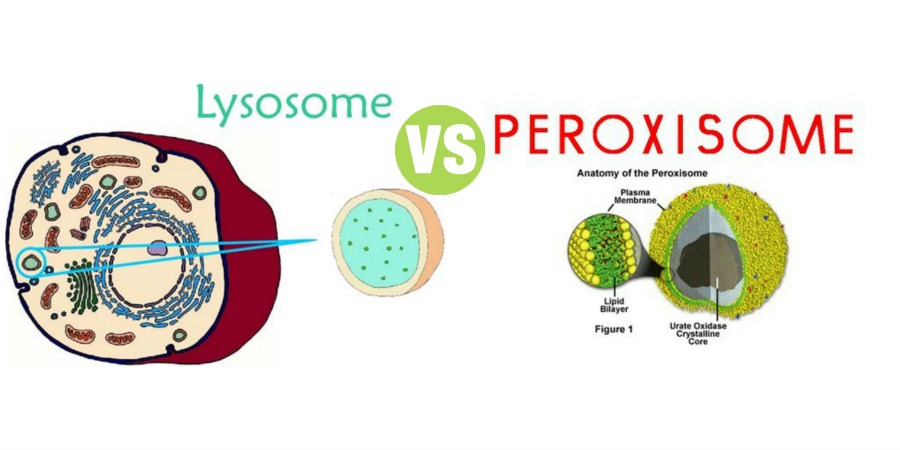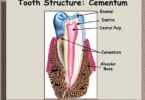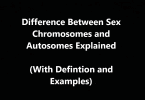Lysosomes vs Peroxisomes
Summary: Difference Between Lysosomes and Peroxisomes is that Lysosomes are the membrane-bound vesicular organelles found throughout the cytoplasm. The lysosomes are formed by Golgi apparatus. The enzymes synthesized in rough endoplasmic reticulum are processed and packed in the form of small vesicles in the Golgi apparatus. Then, these vesicles are pinched off from Golgi apparatus and become the lysosomes. While Peroxisomes or microbodies are the membrane limited vesicles like the lysosomes. Unlike lysosomes, peroxisomes are pinched off from endoplasmic reticulum and not from the Golgi apparatus.

Lysosomes
Lysosomes are the membrane-bound vesicular organelles found throughout the cytoplasm. The lysosomes are formed by Golgi apparatus. The enzymes synthesized in rough endoplasmic reticulum are processed and packed in the form of small vesicles in the Golgi apparatus. Then, these vesicles are pinched off from Golgi apparatus and become the lysosomes. Among the organelles of the cytoplasm, the lysosomes have the thickest covering membrane. The membrane is formed by a bilayered lipid material. It has many small granules which contain hydrolytic enzymes.
Types of Lysosomes
Lysosomes are of two types:
Primary lysosome, which is pinched off from Golgi apparatus. It is inactive in spite of having hydrolytic enzymes.
Secondary lysosome, which is the active lyso some. It is formed by the fusion of a primary lysosome with phagosome or endosome (see below).
Functions of Lysosomes
Lysosomes are often called ‘garbage system’ of the cell because of their degradation activity. About 50 different hydrolytic enzymes, known as acid hydroxylases are pre sent in the lysosomes, through which lysosomes exe cute their functions.
Important Lysosomal Enzymes
- Proteases, which hydrolyze the proteins into amino acids
- Lipases, which hydrolyze the lipids into fatty acids and glycerides
- Amylases, which hydrolyze the polysaccharides into glucose
- Nucleases, which hydrolyze the nucleic acids into mononucleotides.
Mechanism of Lysosomal Function
Lysosomal functions involve two mechanisms:
- Heterophagy: Digestion of extracellular materials engulfed by the cell via endocytosis
- Autophagy: Digestion of intracellular materials such as worn-out cytoplasmic organelles.
Specific Functions of Lysosomes
1. Degradation of Macromolecules
Macromolecules are engulfed by the cell by means of endocytosis (phagocytosis, pinocytosis or receptormediated endocytosis: Chapter 3). The macromolecules such as bacteria, engulfed by the cell via phagocytosis are called phagosomes or vacuoles. The other macromolecules taken inside via pinocytosis or receptor-mediated endocytosis are called endosomes. The primary lysosome fuses with the phagosome or endosome to form the secondary lysosome. The pH in the secondary lysosome becomes acidic and the lysosomal enzymes are activated. The bacteria and the other macromolecules are digested and degraded by these enzymes. The secondary lysosome containing these degraded waste products moves through cytoplasm and fuses with cell membrane. Now the waste products are eliminated by exocytosis.
2. Degradation of Worn-Out Organelles
The rough endoplasmic reticulum wraps itself around the worn-out organelles like mitochondria and form the vacuoles called autophagosomes. One primary lysosome fuses with one autophagosome to form the secondary lysosome. The enzymes in the secondary lysosome are activated. Now, these enzymes digest the contents of autophagosome.
3. Removal of Excess Secretory Products in the Cells
Lysosomes in the cells of the secretory glands remove the excess secretory products by degrading the secretory granules.
4. Secretory function – secretory lysosomes
Recently, lysosomes having secretory function called secretory lysosomes are found in some of the cells, particularly in the cells of immune system. The conventional lysosomes are modified into secretory lysosomes by combining with secretory granules (which contain the particular secretory product of the cell).
Examples of secretory lysosomes:
- Lysosomes in the cytotoxic T lymphocytes and natural killer (NK) cells secrete perforin and granzymes, which destroy both viral-infected cells and tumor cells. Perforin is a pore-forming protein that initiates cell death. Granzymes belong to the family of serine proteases (enzymes that dislodge the peptide bonds of the proteins) and cause the cell death by apoptosis
- Secretory lysosomes of melanocytes secrete melanin
- Secretory lysosomes of mast cells secrete serotonin, which is a vasoconstrictor substance and inflammatory mediator.
More Interesting Information:
Difference Between Dementia and Alzheimer’s
Difference Between Cell and Tissue
Difference Between Enamel and Cementum
Difference Between Tissue and Organ
Difference Between Sexual and Asexual Reproduction
Peroxisomes
Peroxisomes or microbodies are the membrane limited vesicles like the lysosomes. Unlike lysosomes, peroxisomes are pinched off from endoplasmic reticulum and not from the Golgi apparatus. Peroxisomes contain some oxidative enzymes such as catalase, urate oxidase and Damino acid oxidase.
Functions of Peroxisomes
Peroxisomes:
- Breakdown the fatty acids by means of a process called betaoxidation: This is the major function of peroxisomes
- Degrade the toxic substances such as hydrogen peroxide and other metabolic products by means of detoxification. A large number of peroxisomes are present in the cells of liver, which is the major organ for detoxification. Hydrogen peroxide is formed from poisons or alcohol, which enter the cell. Whenever hydrogen peroxide is produced in the cell, the peroxisomes are ruptured and the oxidative enzymes are released. These oxidases destroy hydrogen peroxide and the enzymes which are necessary for the production of hydrogen peroxide
- Form the major site of oxygen utilization in the cells
- Accelerate gluconeogenesis from fats
- Degrade purine to uric acid
- Participate in the formation of myelin
- Play a role in the formation of bile acids.






Leave a Comment
You must be logged in to post a comment.